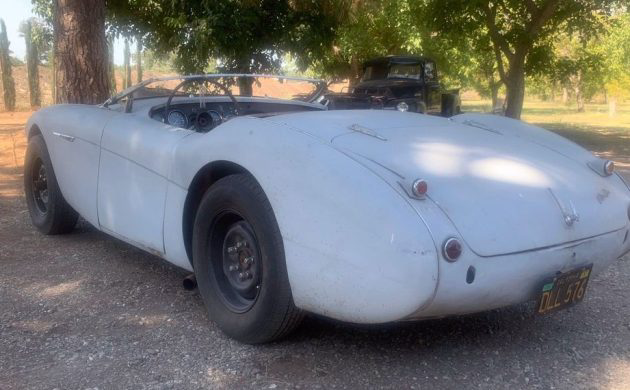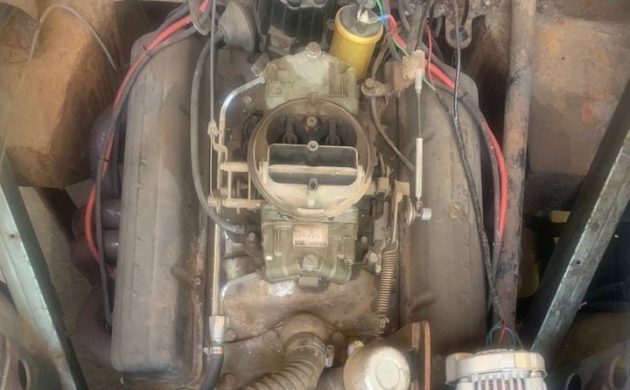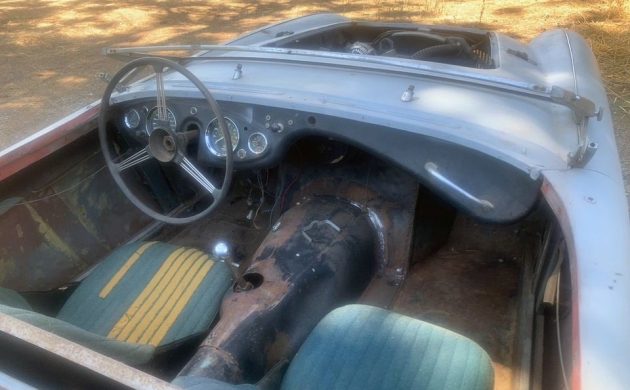The most common criticism leveled against classic British sports cars is a lack of outright performance. The drivetrains for these vehicles were often sourced from humble production cars, meaning high horsepower figures weren’t often achieved. However, this 1956 Austin-Healey 100-4 BN2 rides to the rescue for those unconcerned about total originality. Its engine bay houses a Chevrolet small-block that runs, although the seller offers a couple of alternatives that some readers might find irresistible. I must say a big thank you to Barn Finder T.J. for spotting this intriguing project candidate.
This BN2 rolled off the line in May 1956, with its first owner ordering it in Healey Blue and White. This was an iconic combination chosen by those wishing to help their new purchase to stand out. There isn’t a trace of the original paint visible in the supplied photos, with most of the car wearing Gray primer. Its history is unclear, but the state of the primer suggests it is a long-term project that hasn’t seen much recent cosmetic attention. The panels sport a few minor dings and dents, but what this classic appears to lack is rust. That is unsurprising because the Healey has spent years in a dry location that is ideal for preserving classic steel. There is no word on whether the trim that isn’t attached to the body is included, and it looks like someone has chopped the windshield frame. Locating suitable glass might be a battle, meaning the buyer might choose to source a replacement unmodified frame.
The Austin-Healey BN2 utilized a 2,660cc four that was sourced from the Austin A90 Atlantic. Minor upgrades pushed power and torque to 90hp and 150 ft/lbs, which fed to the rear wheels via a four-speed manual transmission. The model’s “100” designation signified this car’s ability to top 100mph, while the ¼-mile journey took 18.1 seconds. Those figures are now largely irrelevant because much has changed below this classic’s skin. The entire factory drivetrain was consigned to the bin because the engine bay now houses a 265ci Chevrolet V8. Its power feeds through a four-speed Muncie manual transmission to a Chevrolet rear end. The brakes received a welcome upgrade, with the front now equipped with discs from a later Healey. The small-block’s specifications are unclear, but it is fair to expect it to churn out around 195hp and 265 ft/lbs of torque. That should have a profound impact on performance, and the embedded video in the seller’s listing confirms that this Healey runs and drives. However, that isn’t the end of the story, because the seller includes a pair of Ford 302 engine blocks. One is a roller cam version, and as the seller rightly points out, the 302’s narrower width and front-mounted distributor could make it a better proposition in what is a pretty cramped engine bay.
There’s no escaping the fact that this Healey’s interior is a blank canvas. It retains its seats and most of the dash components, but a retrim is required to lift the presentation to an acceptable level. A complete kit will lighten the buyer’s wallet by around $2,000 but will contain every component required to achieve a factory-fresh appearance. Of course, the fact that this car is no longer “stock” might lead the new owner to pursue a custom path. The final decision will be a matter of taste, but since this classic will probably spend most of its life with the soft-top down, they will almost certainly strive for a high-end result.
The seller listed this 1956 Austin-Healey BN2 here on Facebook Marketplace in Chico, California. They set their price at $12,500, meaning it scrapes into the affordable category. It requires work before it can hit the road again, leaving potential buyers to ponder the question of its future mechanical specifications. Sourcing the correct components for a faithful refurbishment is possible, but the prospect of lifting the hood to find a V8 is intriguing. The question is, which would you choose?







It’s okay, people have been stuffing V8s in Big Healeys since I was a lad. This was known as the “Healey Corvette”, similar to the “Healey Cobra” with a Ford V8. Some even used Olds motors. One in much better shape was written up last May for a lot less. The fact a 265 was used may indicate this swap was done a long time ago. Not sure what to do with this thing?
A friend was building one many, many years ago…he called it a Healey Monster…never did finish it and I don’t know what ever happened to it.
Loose the chevy mtr,please.
Really high quality V 8 swaps have gone in the 50K range over on BAT recently, but to get to that level this one would need a lot of money spent. Primer can hide a lot of sins and to bring the body up to high dollar standards could be a challenge. What to do? Spend a few years working on it and make it top quality or just get it driveable and cruise the weekend car shows. Returning to original looks to be out of the question. BTW the windscreen is not cut down, just layed back which was a factory function.
Drove an Olds powered ’55 one time. Lots of fun. Wouldn’t change anything but would finish the exterior and interior as stock.
The reason that British sports cars like this Healey didn’t have what Americans call “outright performance” was because our first motorway only opened in 1959 and the distance was only 63 miles, hardly a great road for a fast cruise in a high powered “American powered”, sports car. As it was this Healey with it’s original 4 cylinder engine could still hit 100 mph so for the Brits it was fast enough!
Both my ’55s would just touch 100 mph, had great brakes, and handled like a race car.
I don’t know, I read the “Preston By-Pass”, opened Dec. 5, 1958, was for high speed travel.
Absolutely correct Howard, however, the Preston By Pass was only a two lane road just over 6 miles long. so hardly what can be classed as a proper motorway, and the chances of hitting 100 mph on it must have been pretty low at that time.
I have no problem with an American V-8 ,but I would want the rest of the car to have an original Healey look!
With all the 300-+ hp four cylinders out there now id go for a more oriiginal looking lighter car that would handle much better and with a 5 or 6 speed tranny it would be a blast to drive
The windshield is OK. These early Healeys had two position mounting and the pics show it in the down mode.
Some good analysis here. It is certainly not as nice as the one shown in May, which eventually sold on BaT for $28,750. Speaking of BaT, other V8 Healeys 100’s sold recently there went for $42K, $45K, $60.5K, $63K, and a whopping $130K for a very nice one listed by Fantasy Junction. It’s not as nice as those cars either. Could you make this one as nice as the $130K car for another $118K? Beats me. This one is for the guy who wants to build it his own way with sweat equity. Probably the cheapest BN2 available with usable floors that moves under its’ own power.
“A complete kit will lighten the buyer’s wallet by around $2,000 but will contain every component required to achieve a factory-fresh appearance.”
Ah…no. 2 grand will earn you an upholsterers disdain. Same with “spend a weekend beating the panels into shape” or “a new battery and some starter fluid and it should fire right up.”
I’m as optimistic as the next guy but there’s either big bucks or hard earned skills required to bring anything back to factory-fresh.
There’s a reason that the small block Chevy was a very common swap into older big Healey’s. The first is that the Healey isn’t that light. It’s got a steel ladder frame and it took some grunt to get it moving. And the small block is lighter than the 6 and almost as light as the all iron 4 banger. Moreover the engine is set back behind the front axle and once you change out the rear axle for something with some beef, with the SBC it’s a very strong car. Not as light as a Cobra since the body isn’t aluminum and the chassis is heavier, but close enough. The 265 was most likely done back in period. but you could plug in anything from a 283 or if you’re greedy a 327 and you’d have something Cobra fast. The 100 roadster is lighter and cooler than the later cars with rear jump seats and the fact that this was all done back in the day makes it a really cool item. While later motors with aluminum heads are lighter, I like the basic SBC and would keep it “period correct”, up until the 70’s the SBC was the “go to” engine to swap into Healey’s. If I was closer I’d seriously consider it.
Center section of the body is aluminum. Fenders and doors are steel. You are right on the weight because the frame looks like it was built for a truck.
Only the front and rear shrouds (the skins that surround the hood and trunk lid) were aluminum the internal body structure was steel.
Healey’s were pretty heavy at 2360 for the 100-4 and 2600 for the 3000. You can now buy aluminum fenders and hood and decklids now so it’s possible to lighten it up a bit and those parts aren’t that bad in price but with a SBC it’s light enough to be a rocket even without going to aluminum parts.
In high school I bought a 1956 100.4 for $300. It only need an oil pan and a battery. Needing an oil pan should have given me pause, but at 15 this was my 2nd car. Got it running and drove it for about a year before one of the rod bearings let go. Could not find a replacement anywhere. An older gentleman who repaired British sportscars offered me a solution. He had a rebuilt Hi Po 289 sitting in his shop collecting dust. He did the measurements and even told me how much lighter the V8 was than my 4 cylinder. To this day I don’t understand why I didn’t take him up on his offer. He was willing to do the install including the price of the motor all for $500. I had someone else try and repair the damaged bearing, re-installed it and drove it for about couple months before I sold the car.
It would be a far easier and less expensive to increase horsepower than to reduce weight with pricey ill fitting alloy fenders, doors, hood and trunk lid, all of which are available but difficult to fit. And not that much lighter than the steel panels. The 265, although lighter than the Healey 4, has a modest 180 horses when fitted with a four barrel carb and dual exhaust. There is a whole spectrum of higher HP externally identical bolt in SBC engines that can be had for under a thousand bucks. Better yet, use one of the SBF 302 motors that come with the car, spend the thousand bucks on a pair of aluminum heads, get a roller cam and some decent pistons. While the machine shop is working on the motor, sort out the sloppy welding on the motor mounts and toe boxes. The SBF is narrower than the SBC so a better fit, and the distributor is in the front, which solves another problem.
On the other hand, there’s plenty of power with the current engine, it runs well, and, coincidentally I’m sure, it is the same year as the car. And, it’s already lighter than a Cobra.